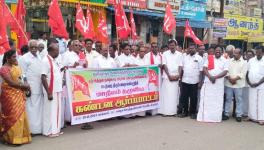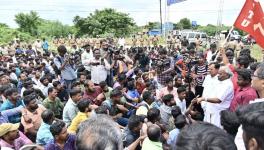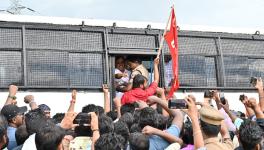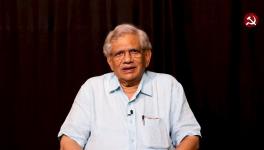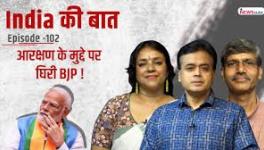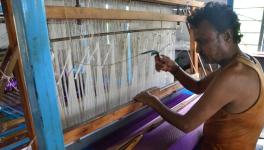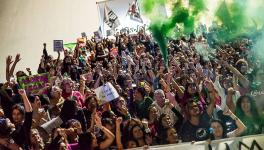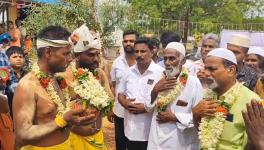TN: Govt Memorial for 21 Police Firing Deaths. What Is It About?
1987 Vanniyar reservation protest. Image courtesy: Frontline
On September 2, the DMK government in Tamil Nadu announced the construction of a memorial in Villupuram district for the people killed in police firing and clashes in 1987.
The incident was part of the movement demanding reservation for the Vanniyar community. This announcement was made with the local body polls round the corner and right before the anniversary of the killings on September 17.
What exactly happened in the 1980s that led to the death of 21 people in a protest? And, what were the outcomes of the struggles?
WHO ARE THE VANNIYARS?
Vanniyar, a community largely concentrated in northern Tamil Nadu (the region that was formerly known as South Arcot in Madras Presidency of British India), accounts for about 12% of the state’s population.
The Vanniyar community, which is classified under the backward classes, is the largest of the BCs and makes up for about one-fifth of the total BC population in the state.
Vanniyars were predominantly landless labourers, and their economic conditions were not very different from those of the local Scheduled Castes. The community was very backward in education and employment, and unable to compete with other BC communities who had already advanced.
They resented their traditional name of Padayachi (soldier) and changed it to ‘Vanniyala Kshatriya’ claiming high-caste status, as a means of social mobility. But, they claimed low caste status in their fierce struggle for access to resources.
STRUGGLE FOR RESERVATION
Intense protests were held in the mid-1980s under the leadership of the Vanniyar Sangam demanding separate reservation for the Vanniyar community.
The organisation claims that Vanniyars formed more than 25% of the state’s population, and thereby they should be given at least 20% reservation. They argued that out of the 50% reservation for OBCs, the Vanniyar people got only 1% of the total benefits.
Initially, the sporadic protests organised by the Vanniyar Sangam did not put pressure on the government. In 1986, they were involved in processions, demonstrations, road blockades and rail rokos, but they failed to capture the attention of the government.
When all of these were of no avail, the Vanniyar community leaders decided to mobilize the people of the community and launch a massive struggle. They went from village to village targeting the youth and campaigning about the status of Vanniyars in society.
This resulted in a one-week road block agitation in September 1987, and Dr S Ramadoss (who later founded the Vanniyar majority party Pattali Makkal Katchi (PMK)), spearheaded the struggle.
Tall roadside trees were cut down and thrown onto the road to create heavy traffic, which caught the government’s attention. Meanwhile, Ramadoss was arrested and lodged in the Madras Central Prison. Day by day the struggle began to intensify, and it continued for a week.
The MGR-led AIADMK government refused to negotiate with the Vanniyar leaders, instead it mobilised the police and paramilitary to suppress the protestors.
On September 17, north Tamil Nadu became a battleground, police firing claimed 21 lives 20,000 people were arrested.
RESULT OF THE STRUGGLE
With the death of MGR in December 1987, the President’s Rule was in place and there was no solution in sight. As a result, the Vanniyar Sangam in August 1988 threatened to boycott elections to the Tamil Nadu assembly.
In consequence of the pressure from the Vanniyar Sangam, and as an electoral ploy of the central ruling party Congress, on the eve December 1988 state elections, the Tamil Nadu governor announced compartmental reservation. Its actual implementation was, however, postponed to after a proposed survey of the backward class population.
The DMK went on to win the assembly elections and assumed office in January 1989. Partly in fulfilment of one of its poll-promises and partly to outwit its opponent Congress, the DMK ministry stopped the BC survey and ordered direct compartmental reservation.
At the behest of the Tamil Nadu government, a Constitutional Amendment was brought about in 1994 to implement reservation within reservation. Further, the Amendment was included in the Ninth Schedule of the Constitution in order to protect it from being challenged in the courts.
It provided for a total of 69% reservation for the weaker sections of the population including the SCs, STs, and OBCs. Notably, the Amendment runs counter to the prevailing judgement of the Supreme Court which has ruled that reservations shall not exceed 50% in total.
Since then, out of the 50% reservation for the OBCs (comprising 201 communities and representing 67% of the state’s population), 20% was set apart for the MBC (comprising 108 communities). Vanniyars constitute 53% of the population of the most backward section, which means they are likely to get a sizable share of the 20% reservation.
ONGOING POLITICS OF RESERVATION
The demand for Vanniyar reservations did not end there. The PMK, which was formed out of the Vanniyar Sangam, has repeatedly raised reservation demands.
The demand for exclusive Vanniyar reservation of 20% was brought up even as part of the recent alliance talks with the AIADMK before the April 2021 assembly elections.
Some information taken from:
M N Srinivas’ Caste: Its 20th Century Avatar
R Vidyasagar’s V anniyars’ Agitation
News18’s Vanniyar Reservation Protests… Gun Fires… 21 Deaths - What Happened in
Get the latest reports & analysis with people's perspective on Protests, movements & deep analytical videos, discussions of the current affairs in your Telegram app. Subscribe to NewsClick's Telegram channel & get Real-Time updates on stories, as they get published on our website.










